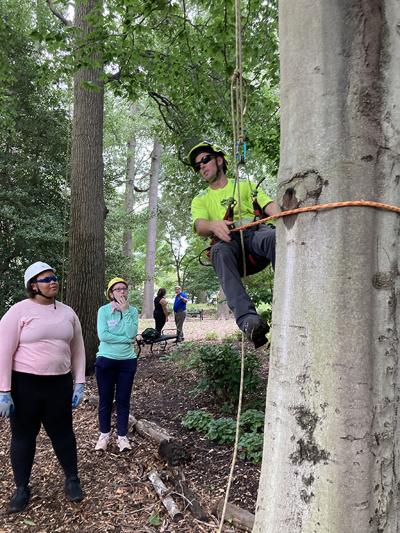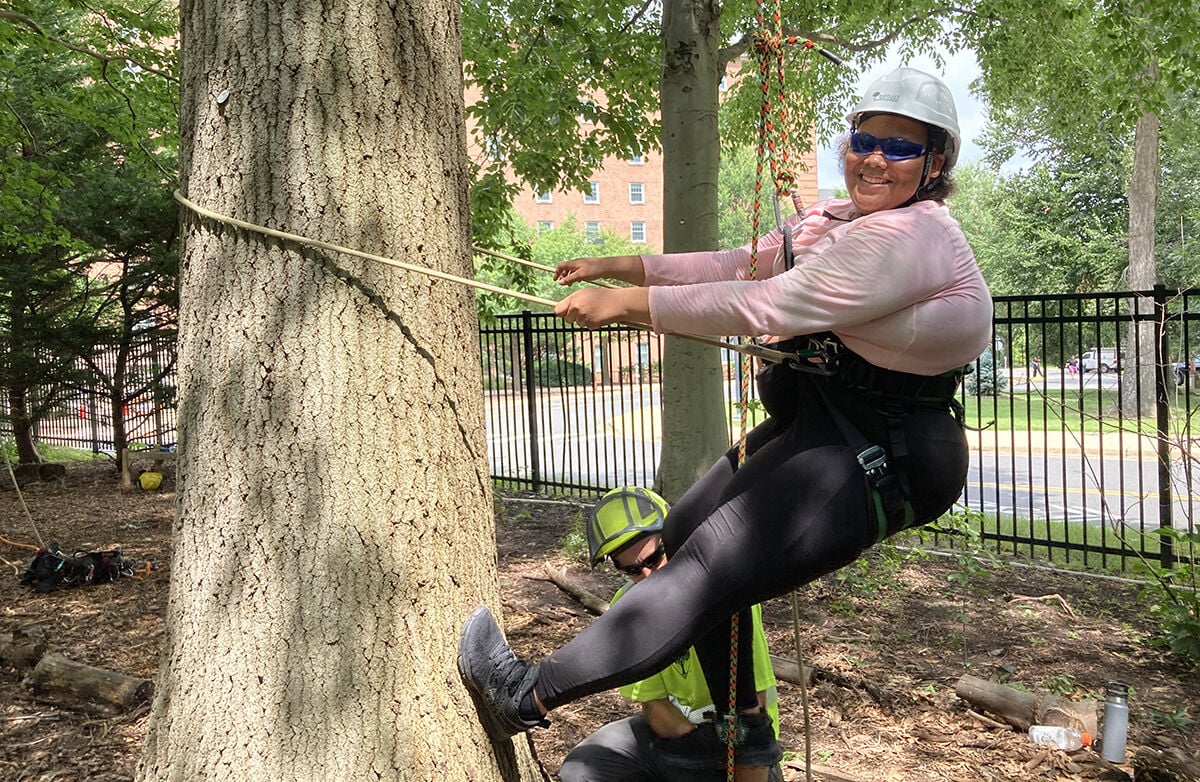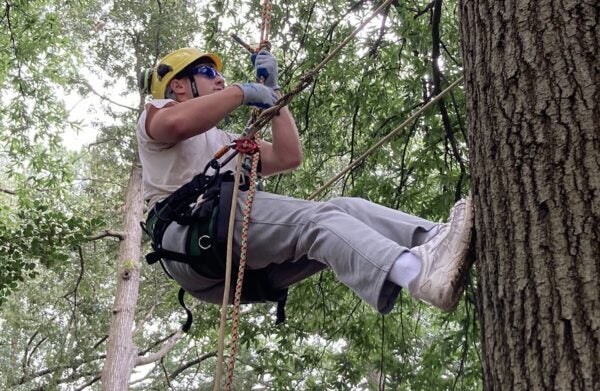
By Timothy B. Wheeler
Talk about pulling yourself up by your bootstraps. That’s just what Nevaeh Murphy managed to do on her second try one muggy morning this summer.
“I did it!” the beaming Bladensburg teen exulted, after tugging and pushing herself a few feet up a towering oak tree on the University of Maryland, College Park campus.
Nevaeh was one of 32 high school students who spent a week in July at an Urban Forestry Careers Camp climbing trees, tracking deer, watching arborists at work and learning about jobs in the care and management of trees in cities and suburbs.
Tree climbing provided perhaps the students’ biggest challenge. After struggling to get off the ground on her first attempt, Nevaeh achieved liftoff the second try with a foot strap attached to the arborist’s tree-climbing gear that she had donned. It enabled her to use her leg muscles as well as her arms to inch up the rope dangling from the tree trunk.
The camp, sponsored by the Maryland Forestry Foundation, is an offshoot of the larger Natural Resources Careers Camp held every July for the past 45 years in woodsy Garrett County.
Launched as a pilot program two years ago, the camp at the College Park campus aims to help high school students learn about urban forestry occupations through hands-on exercises, field trips to places like the National Arboretum and interactions with professors, practicing arborists and other experts.
The students received practical demonstrations of how to conduct tree inventories, diagnose tree diseases and reduce damage by deer and other wildlife in urban and suburban settings. They also learned about the multiple climate, environmental and health benefits of tree canopy in urban areas.
“It’s to introduce you,” explained Ashley Freeman, a safety coordinator for Bartlett Tree Experts, to the kind of work he and his coworkers do. “You might decide you like it.”
The camp’s location at College Park is no coincidence. The university offers a multidisciplinary program in urban forestry.
“We want to professionalize urban forestry,” said Joseph Sullivan, professor and associate dean of the school’s College of Agriculture and Natural Resources.

It is a career that seems vital to the Chesapeake Bay restoration effort, which has labored in vain to expand the urban tree canopy throughout the six-state watershed.
Despite ambitious tree planting campaigns, the impacts of development, disease and pests in many places are killing urban trees faster than they can be replaced.
Now, instead of seeking to expand the watershed’s urban tree canopy by the relatively modest amount of 2,400 acres by the end of 2025, as pledged in the 2014 Chesapeake Bay Watershed Agreement, the state-federal Bay Program is considering lowering its goal. The draft revision to the pact simply calls for reducing the loss of existing urban tree canopy and ultimately planting enough trees to achieve a net gain long-term by an unspecified date.
The camp costs $2,500 per youngster, but the bulk of the tuition is covered by the Maryland Forestry Foundation, a nonprofit that receives a grant for that purpose from the state Department of Natural Resources. Attendees are asked to pay just $150 each.
Gary Allen, president of the forestry foundation, said that when the 3-year pilot runs its course next year, he’s hoping that local government agencies in need of employees with urban forestry skills will kick in financial support to keep the program going.

For many of the students, this was their first exposure to urban forestry.
“I’m more of a chemistry girl,” said Emily Simmons, a high school senior from Bel Air. “I came to [camp] knowing nothing about trees. I’m learning a lot.”
Blake Graham, a senior from North Potomac said he applied to attend the camp after hearing about it at an open house. He said he climbed trees for fun when he was younger but nothing like the massive oaks and beeches the students were taught to scale by employees of Bartlett Tree Experts, a family-owned tree and shrub care company with 125 offices worldwide.
With a Bartlett employee coaching, each prospective climber strapped on a “saddle,” a harness that was then clipped to a rope looped over an upper limb of the tree.
The “old-school” double-rope system employed meant the climber only had to pull roughly half of his or her body weight. And with a sliding hitch to support the climber’s weight between pulls, each could ascend in a series of small hauls up the rope, often helped along by using feet to walk up the trunk.
Some took to climbing quickly.
Fiona Cox, a senior from Takoma Park, scrambled like a pro nearly to the top of a big beech tree. When asked if she was ready to come down, she replied, “Yeah, unless you’ve got a higher tree.”
Fiona said she was intrigued to learn about “food forests,” a planned collection of various edible plants, including trees and shrubs, that attempts to mimic a natural forest.
“I like tree identification,” she added. But despite her skill at tree climbing, she said she didn’t think urban forestry was for her. Instead, she had her eyes set on studying the related field of horticulture at the University of Maryland.
It might have just been nerves, but as Nevaeh Murphy suited up for her first climbing attempt, she blurted out that she actually hates trees because of the bugs that they attract. Climbing a tree only added to her anxiety. “I’ve never been this scared in my life,” she said.
After trying and concluding that she lacked the upper body strength to do it, Nevaeh sat quietly watching others follow her with varying degrees of success. Ultimately, she decided to give it another go.
With the aid of the foot strap, she got off the ground enough to claim victory.
Nevaeh, a sophomore, said she was thinking about a career in architecture rather than urban forestry because she likes designing things. Even so, she said she enjoyed the group’s visit to the National Arboretum and to Casey Trees, a nonprofit working to restore and enhance tree canopy in the District of Columbia.
After the tree-climbing exercise, when asked as a group what they thought of it, the students gave a variety of responses, from “great” to “made my tummy hurt” to the middling “painful but fun.”
Sounds like how work of any type can make a person feel on any given day. Get those bootstraps ready.
